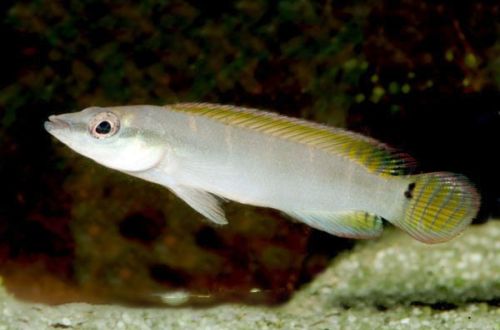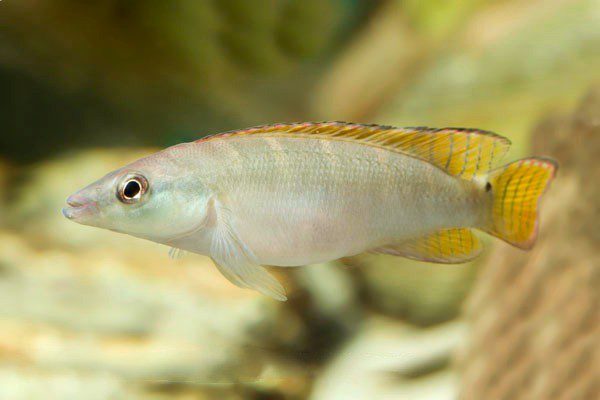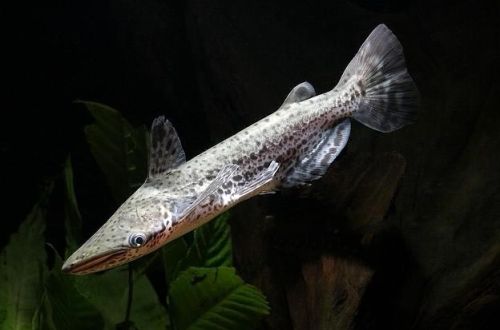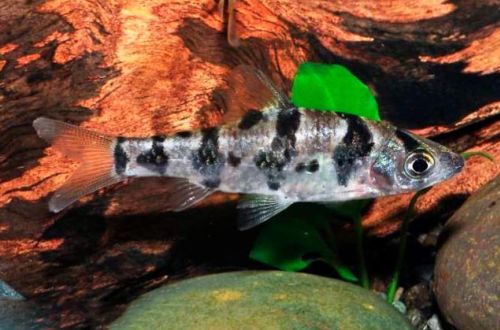
She left
Krenichla, scientific name Crenicichla compressiceps, belongs to the family Cichlidae (Cichlids). The fish is native to South America. Inhabits the lower basin of the Tocantins River, located in the east of the continent in Brazil.

Contents
Habitat
It lives in lakes, streams and rivers, as well as in the floodplains of most water bodies of the Tocantins basin. Prefers regions with clean running water, sandy substrates and accumulations of stones and boulders.
Description
Adult individuals reach a length of up to 6 cm. Outwardly, it resembles a small pike, having an elongated body and a wide muzzle with a large mouth. The large dorsal fin extends from head to tail.

The main color is greenish-yellow. 6-8 vertical yellow stripes run along the body. The dorsal, anal and caudal fins are also yellow and striped with four dark stripes.
Males are thinner than females.
Behavior and Compatibility
Active moving fish. Krenichla is a small carnivore. Has not the most friendly disposition. May be aggressive towards smaller fish. And those who are able to fit in her mouth will certainly be considered as food and an object of hunting. Only larger species are allowed as neighbors.
They have a grumpy character and do not favor relatives in their territory. It is recommended to purchase a pair of male and female or a large group of 10 fish with a predominance of females. It is noted that if during the breeding season the number of males significantly exceeds the number of females, then the latter can suffer greatly from excessive attention, up to death.
In large groups, given enough space, intraspecific aggression will be dispersed throughout the population. A smaller number (from 2 to 10) in a limited space can lead to skirmishes for territory and the death of weaker fish.
Brief information:
- The volume of the aquarium – from 150 liters.
- Temperature – 24-27°C
- Value pH — 5.0–6.8
- Water hardness – soft (2-8 dGH)
- Substrate type – soft sandy
- Lighting – any
- Brackish water – no
- Water movement – moderate
- The size of the fish is about 6 cm.
- Nutrition – foods high in protein
- Temperament – inhospitable
- Keeping in a pair male female or large groups of 10 individuals
Maintenance and care, arrangement of the aquarium
The fish are small, but given their difficult nature, for a group of 10 individuals, it is necessary to provide a tank with a volume of 450–500 liters. For a pair of Krenitsichla fish and several neighbors of other species, an aquarium of 160 liters or more is required.
The design uses a soft sandy substrate and several places for shelters from snags or piles of stones, rock fragments. Aquatic plants are rarely found in the natural habitat of this species. It is acceptable to use plants that can grow on the surface of snags and stones, for example, numerous mosses and ferns, as well as rooting anubias.
It is recommended to ensure the movement of water using an additional pump or a productive filter.
The optimal conditions are warm soft water, rich in oxygen, and a minimum content of nitrates. Do not allow the accumulation of organic waste. For long-term keeping, the smooth operation of the filtration system and regular maintenance of the aquarium are important.
Food
In nature, they hunt from shelters for small fish, aquatic insects and their larvae, and other invertebrates. Or they swim among stones and snags in search of prey. In a home aquarium, it is important to provide a diet rich in protein. A sinking food with a high protein content is a good choice. A great addition would be fresh or freeze-dried bloodworms.
Breeding / breeding
Breeding is possible, but comes with many difficulties. The main problem is the high level of aggression during spawning. When a pair forms a clutch, they begin to defend it fiercely, attacking anyone who gets close enough.
In the period preceding spawning, it is necessary to reduce aggression in order to strengthen pair bonds. For this purpose, breeders use “target fish” – this is a target fish that serves as an object of aggression. It can be chosen among other relatives or a representative of other species.
There are up to 50 eggs in a clutch. The incubation period lasts 2-3 days. After another 4 days, the fry begin to swim freely. Parents take care of the offspring for quite a long time, protecting it, and all this time they are a danger to other fish.
Sources: fishbase.se, tfhmagazine.com





